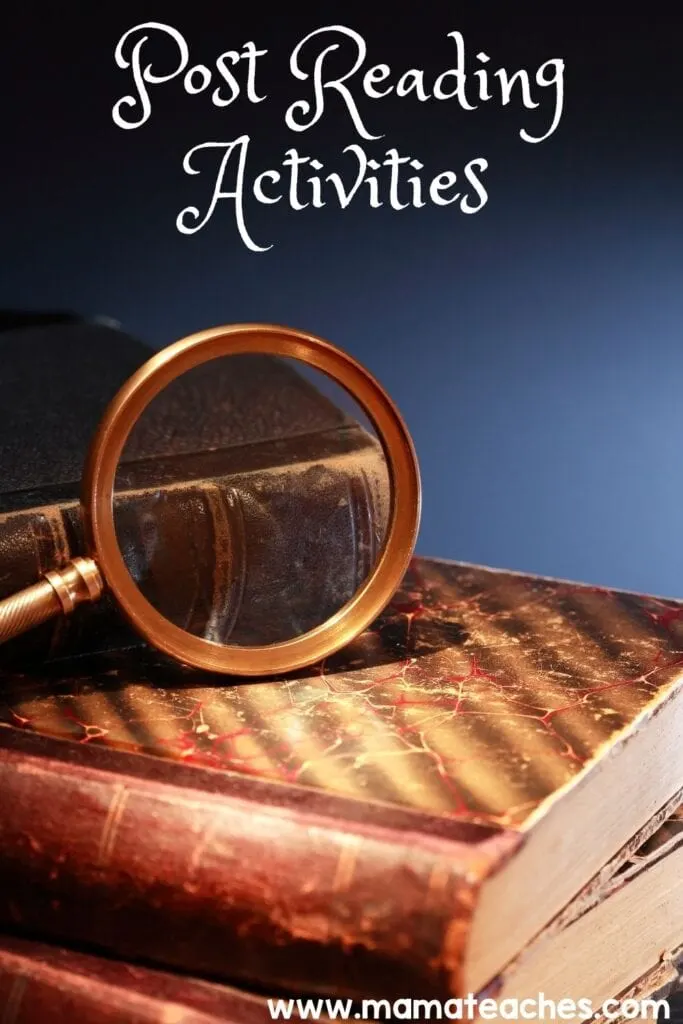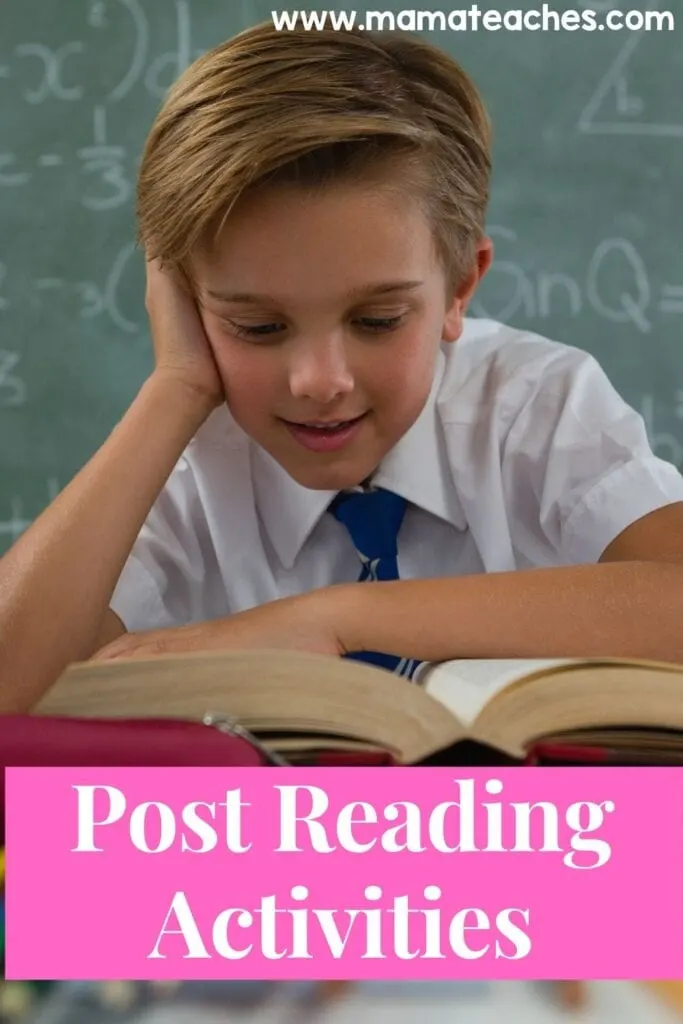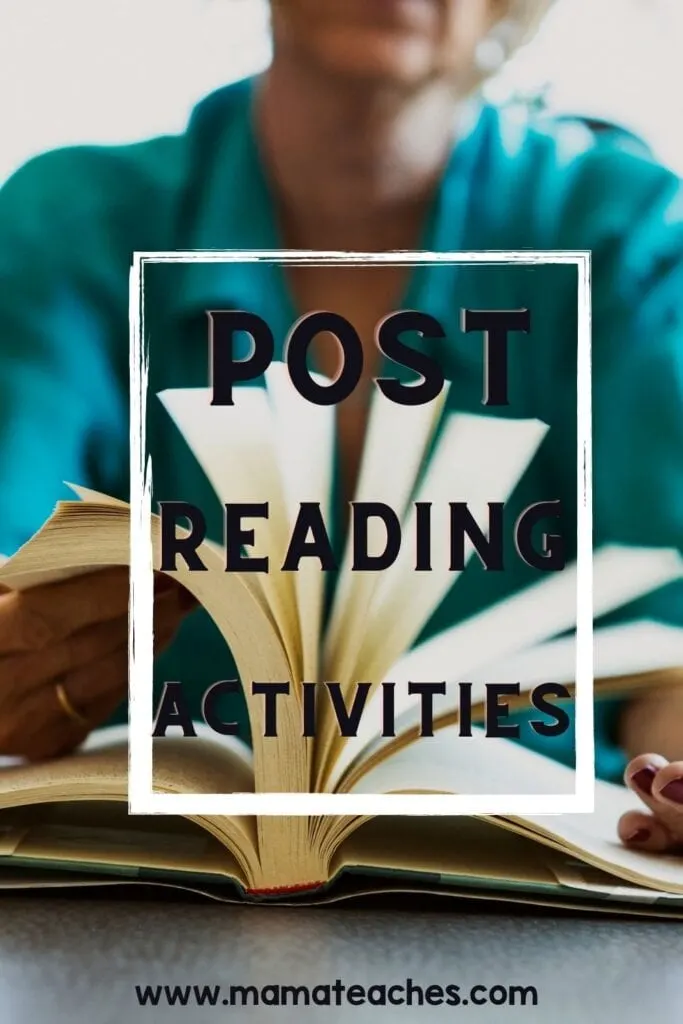The End. Those are often the last words in a story.
But should that be the end of reading? Not at all!
Read on for post reading activities for students of all ages.

This article contains affiliate links to things that you might like.
What Are Post Reading Activities
Reading a piece of writing is like juicing a fruit. You select and examine the fruit (that’s pre-reading).
Then you slice it open to reveal its contents (that’s reading).
The final activity is twisting the fruit on a juicer to get out every last drop of sweet juice (that’s post reading).
Post reading consists of after reading activities completed either immediately after reading or on the following class day.
They can include summarizing, acting, drawing, outlining, or writing about what the student read.

Benefits of Post Reading Activities
Have you ever read a page of a book only to find you have no idea what it said?
Typically you are reading silently to yourself and your mind wanders off.
You read the page in a sense, but you don’t absorb the contents.
To truly read a passage is to be able to decode the words and understand what the passage is about. This three-step process is:
- Decoding
- Comprehending
- Reflecting (which leads to deeper understanding)
Post reading activities can help strengthen your student’s skills in each of those three steps.
You give the student tools to break down what he reads and extract every last drop of juice from a piece of writing.

Ideas for Post Reading Activities
Post reading activities are a must for every age of reader (even adults!) If you have ever kept a reading journal, attended a book club, or summarized a book for a friend, you have engaged in post reading activities.
Here are ideas for age-appropriate post-reading activities.
Peruse the whole list because many of these activities work well across several ages.
Preschool/Kindergarten
- Unscramble and Reassemble. Pick a sight word from the story and assemble it with letter tiles or magnets. Have the student unscramble it and then reassemble it.
- Trace It. Write a new word from the passage on lined paper. Tape a piece of tracing paper over the word to have the child trace it. You can scootch the tracing paper to do this several times (use a different color thin-tipped marker each time to create a rainbow array of the word).
- Character Portrait. Discuss one of the characters from a story. What was he/she like? Then have the students draw a portrait of the character.
Early Elementary
- Sentence Train. Write a sentence from the passage in large letters and cut it apart word by word. Have the students unscramble it, read it, and reassemble it.
- Act It Out. Discuss the action of the story, and then pick roles to act it out in pantomime.
- Oral Book Review. Did the student like the story? Why or why not? Let her explain her reasons.
Upper Elementary
- Summary of Main Points. After reading informational writing, can the student remember and summarize the main points?
- Story Sequence Chart. Fill out a story sequence chart with characters, setting, conflict, and resolution.
- Vocab Spider Bubble. Put new words in a center bubble (the body of the spider). Now send off lines (legs) that end in more information about the word. This could be the definition, other forms of the word, the word in a sentence, synonyms, antonyms, and the word divided into syllables.

Middle School
- Venn Diagram. Middle schoolers love to compare and contrast characters with this easy-to-draw graphic organizer.
- Outline. It doesn’t have to be formal, but ask the student to outline the passage. What are the main points?
- A New Point of View. Stories are usually written from one character’s point of view. How would the story change if it were told by another character?
High School
- Character Chart. List the characters of the story and brief description of each.
- Write a Quiz. Have the students compose their own quizzes to test for comprehension of the passage.
- Musical Mood. What pieces of music would be the ideal backing tracks for various scenes in the book?
- Rewrite the Ending. Write a new ending for the book.

Activities for Post Reading
Post reading activities are a fun and helpful way to ensure that a student gleans all he can from a passage or book.
